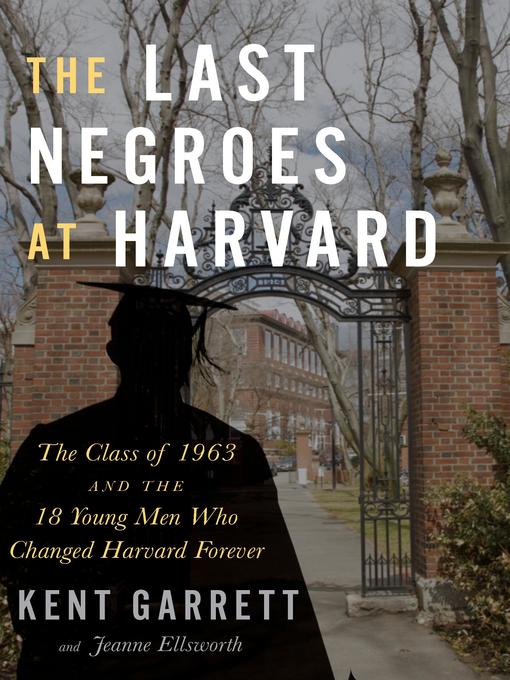
The Last Negroes at Harvard
The Class of 1963 and the 18 Young Men Who Changed Harvard Forever
کتاب های مرتبط
- اطلاعات
- نقد و بررسی
- دیدگاه کاربران
نقد و بررسی

November 15, 2019
An alumnus of the Harvard class of 1963 recounts an experiment in affirmative action and its lasting effects. Before 1959, the African American presence at Harvard was minimal to the point of being practically nonexistent. That year, the university recruited 18 young black men--women did not yet enter into the picture--one of them Garrett, who went on to excel in TV news and documentary-making. "I was by no means the first Black at Harvard," he writes. "That was Richard Theodore Greener, who graduated in 1870. From then until the mid-twentieth century, there were sometimes one or two in a class, and often none." The other 17 men were just as capable. In a kind of modern rejoinder to Michael Medved and David Wallechinsky's What Really Happened to the Class of '65? Garrett traces their lives and careers. All acknowledge that a Harvard education had its uses, but most also allow that during their student years, they kept quiet and did their work, careful not to give any reason to be forced out. Some of the former students are expatriates, having found other countries more congenial than the still racially troubled United States. One gentleman who has long lived in Austria after a career at IBM remembers going to student mixers and having classmates rush out to find a black girl for him to dance with: "There we were, the two of us, and all these whites just standing there glowing, saying 'Isn't it great?' It was very embarrassing for her and for me." Rueful reminiscence sometimes shades into anger, but for the most part, these extraordinary men chart life journeys that were full of challenges--as with a closeted gay classmate who went on to careers in the aerospace, banking, and advertising sectors--but also full of accomplishments. Garrett writes with an easy, charming style ("In the spring of 1962, I was still trying to climb the steep and slippery slope of organic chemistry"), but the sense of injustice is palpable. A fine contribution to the literature of civil rights and the African American experience.
COPYRIGHT(2019) Kirkus Reviews, ALL RIGHTS RESERVED.

Starred review from December 16, 2019
Former NBC News producer Garrett reflects on his 1959 arrival at Harvard University as one of “the largest group of Negroes admitted to a freshman class to date” and interviews 14 of his 17 fellow African-American classmates about their experiences in this vivid and perceptive debut. A Brooklyn native, Garrett spent his childhood summers in South Carolina, where his relatives conveyed “a visceral sense of fear” around local whites. At Harvard, Garrett’s classmates included Wesley Williams, a member of the “elite Negro world” of Washington, D.C., and George Jones from segregated Muskogee, Okla. “Almost from the first day,” Garrett writes, “we Negroes started noticing each other, making mental note of who and where the brothers were.” He describes eating at the “Black Table” in the freshman dining hall and attending house parties in nearby Roxbury, as well as Malcolm X’s 1961 campus visit to debate the merits of integration. Reconnecting with his classmates 50 years later, Garrett notes many educational and professional achievements, including the founding of the African and Afro American Association of Students at Harvard, but laments that their lives have been “bracketed” by Jim Crow and Trumpism. He and coauthor Ellsworth eloquently describe the pressures these students were under, drawing an insightful portrait of the limits of racial progress in America. Expertly blending memoir and cultural history, this outstanding retrospective deserves to be widely read.

Starred review from October 1, 2019
Garrett was one of 18 young black men who in 1959 enrolled at Harvard. Many of these students were recruited from America's inner cities or Southern towns because of their race and academic achievements. The title refers to the shifts in racial politics that took place around the time this group graduated in 1963. Former TV and film producer Garrett's beautifully written narrative, coauthored by educator Ellsworth, offeres a gripping snapshot of how these students "stood out and blended in" as the largest incoming Harvard class of African Americans to date and for a number of years to come. (That said, these 18 students represented just 1.595 percent of the freshman class.) Race and class sometimes kept students apart, starting with the young men's choice to sit together during meals. Garrett is a keen observer of his fellow students, and he explores how this experience sharpened his critical thinking skills and raised his consciousness of Negroes as Afro-Americans (later African Americans), Afro-Caribbeans, and Africans. The author draws from his firsthand knowledge and interviews conducted over a ten-year period with 14 of his surviving classmates and their loved ones, supplemented by anecdotes about classmates who died and others who attended or taught at Harvard at that time. VERDICT Essential reading for those interested in civil rights, racial identity, and higher education. [See Prepub Alert, 8/5/19.]--Elizabeth Connor, Daniel Lib., The Citadel, Military Coll. of South Carolina, Charleston
Copyright 2019 Library Journal, LLC Used with permission.

October 1, 2019
In fall 1959, antedating affirmative action, Harvard took the unprecedented action of admitting 18 "Negro" boys who would, with the changing times, graduate as African Americans. Garrett was one of them. A groundbreaking journalist who dumped the high-pressure business world to run an upstate New York dairy farm with partner Ellsworth, Garrett tracks down his 17 compatriots to discuss their wide-ranging backgrounds and experiences. With a 30,000-copy first printing.
Copyright 2019 Library Journal, LLC Used with permission.

























دیدگاه کاربران